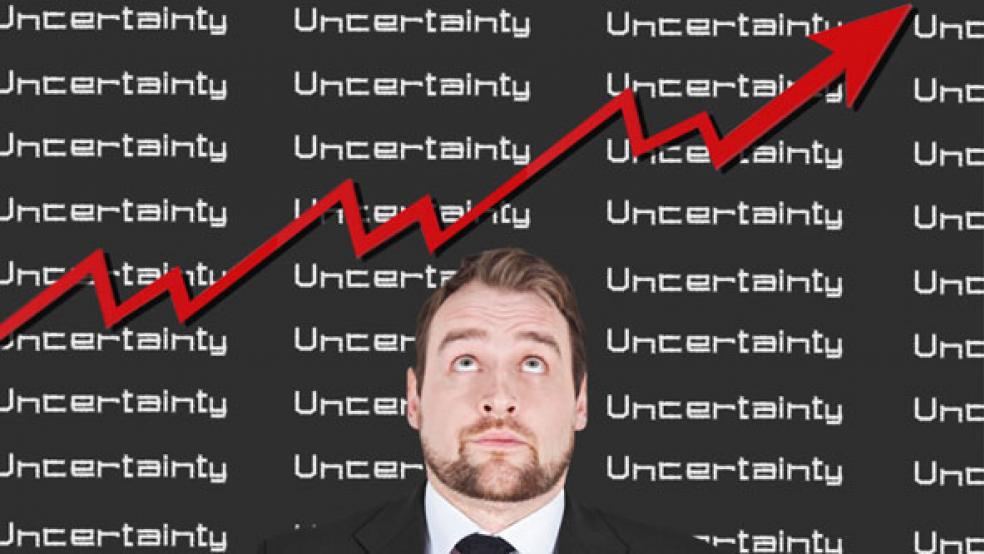Economic clouds are gathering again, as growth in the job market slows and questions about the future of the Eurozone continue to swirl. On the horizon, the fiscal cliff looms, with its perilous combination of federal tax hikes and spending cuts. Just how much is the policy uncertainty impeding the economic recovery?
To bring some clarity to that question, The Fiscal Times spoke with Steven J. Davis, an economist at the University of Chicago Booth School of Business and the co-author of a recent paper that built on the work of, among many others, a young economist named Ben Bernanke, who in 1983 examined “Irreversibility, Uncertainty and Cyclical Investment” in the Quarterly Journal of Economics. Davis and his colleagues Scott Baker and Nicholas Bloom of Stanford developed an “Economic Policy Uncertainty Index” that shows how ambiguity has jumped higher in recent years, peaking with the debt-ceiling debacle last summer. The question now is whether we’re heading for an even more alarming level of uncertainty.
The Fiscal Times: Give me a sense of how economic uncertainty plays out in America’s boardrooms or in corporate planning meetings.
Steven Davis: I’ll give you an example. There is a lot of uncertainty right now about what tax rates on capital gains will look like one, two, three, four, five years down the road. The reason I emphasize that is because President Obama and Governor Romney obviously have very different plans with regard to the taxation of capital gains. There’s a lot of uncertainty about just how the capital gains portion of returns on business investments will be treated. And of course there is also quite a bit of uncertainty about what tax rates are going to look like, especially for middle income and higher income people.
There is uncertainty about how dividends are going to be treated by the tax system going forward. There is quite a bit of uncertainty about the corporate tax rates. Those are all things that affect the after-tax rate of return to business investment or the ability of businesses to attract funds from investors. Something like the capital gains tax treatment may not affect a business directly, but indirectly through the eagerness of others to invest in a business. I think of those as things that affect straightforward business decisions every day. And I can’t really think of another time in recent memory when there has been so much uncertainty about how business income and business profits will be taxed over the next several years.
TFT: Your data show that the uncertainty that we are facing now is actually significantly lower than it had been just last summer, but is still historically high.
SD: That’s right, last summer was the peak in the time period we looked at back to 1985. So there’s both good news and bad news. The bad news is policy uncertainty remains quite high relative to pre-financial crisis levels, but it did come down a lot after the debt ceiling debate was resolved – at least resolved for the moment.
TFT: We have so many of those same issues coming up again, though. They’ve just been deferred.
SD: There is fairly strong evidence that high levels of policy uncertainty foreshadow or precede deteriorations in macroeconomic performance as measured by things like employment growth, business investment, business hiring and those types of things. One wants to be careful about drawing causal inferences from timing relationships in the data, and that’s why I was careful to use the word foreshadow. If you see policy uncertainty rising, that should be a factor that causes you to revise downward your assessment of future performance. But to make strong causal interpretation you have to dig in more deeply as to why policy uncertainty is rising. And that’s a challenging issue.
TFT: So you are confident about the correlation but less so about the direct causation?
SD: Yeah. My own reading of the data is that there are a variety of factors that underlie fluctuations over time in policy uncertainty. Some of them I think are reasonably interpreted as the policy process itself causing problems for the economy. And I think the debt ceiling debate of last summer is a perfect example of this, as is the uncertainty surrounding the fiscal cliff that we are coming up on. But there are others.
For example, in the wake of the global financial crisis monetary policy makers and to some extent fiscal policy makers were confronted with unusual and very challenging policy questions that naturally raised a lot of uncertainty. The uncertainty that occurred in the wake of the financial crisis may well be one reason why there have been such negative and long-lasting effects on the economy.
TFT: If there are those two factors behind uncertainty, how much of it at this stage is the process and the dysfunction that we are seeing in Washington? Is there a way to tease that out from the data?
SD: I don’t have a precise way to do that. I do think it’s noteworthy that towards the latter half of 2009 our index value came down a lot. By the middle of 2009, the worst aspects of the financial crisis in the U.S. had been contained and fears that we might actually head off an economic cliff and return to something like the Great Depression had abated considerably. I think some combination of dysfunction in the policymaking process and deliberate decisions made by political leaders played an independent role in pushing policy uncertainty levels back up.
I think decisions about labor market policy, most notably the National Labor Board Relations treatment of the Boeing investment in South Carolina was something that injected uncertainty about how business investments would be treated by the government. That was a source of uncertainty that in my view was injected by policy makers and in a way that made businesses – or at least some businesses – more reluctant to invest. It is a clear example of decisions that were made by policymakers that I think contributed unnecessarily to the amount of economic uncertainty in the environment and thereby contributed to a slowdown in investment and hiring. Along similar lines, I also take a somewhat dim view of the structure of the Affordable Care Act and the way it was passed.
The bottom line the period since 2010 is quite different than the period of 2008 and 2009 in terms of the dysfunctional policymaking process and deliberate policy decisions that have been a factor driving policy uncertainty to high levels.
TFT: But there is always uncertainty surrounding business planning. In these cases, to what extent is it important to have specific resolutions that would allow businesses to move forward and the economy to hopefully grow? Or is it more important that these issues get resolved in any way, as long as they are resolved?
SD: I agree that there is always an inherent amount of uncertainty in the economic environment. The question is whether policy makers are needlessly and without obvious benefit adding to the uncertainty of the economic environment, which discourages business investment and hiring. And it probably also reduces consumption spending by households.
TFT: If we were to have another debt-ceiling crisis like we had last summer, do you think it could be as bad as last summer or potentially worse?
SD: I am hopeful it won’t get as bad as last summer because I don’t think policy makers on the Democratic or Republican side came out of that debacle looking good. I think people recognize that it was a needless source of uncertainty that was making lives difficult for businesses and individuals in an economic life that is difficult enough without the government adding to it. And they did it in such a visible way. I am, I guess, more hopeful that cooler heads will prevail this time.




